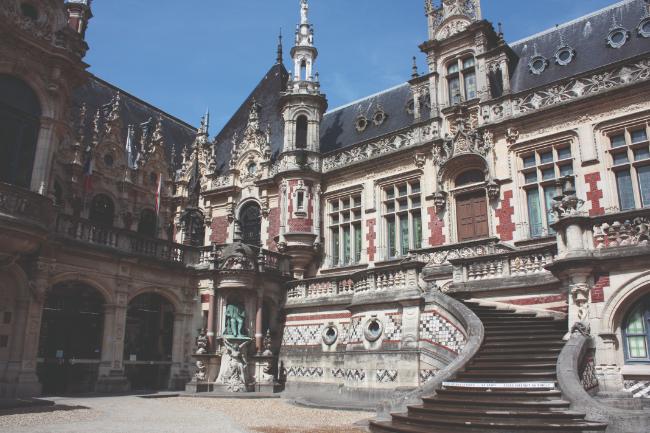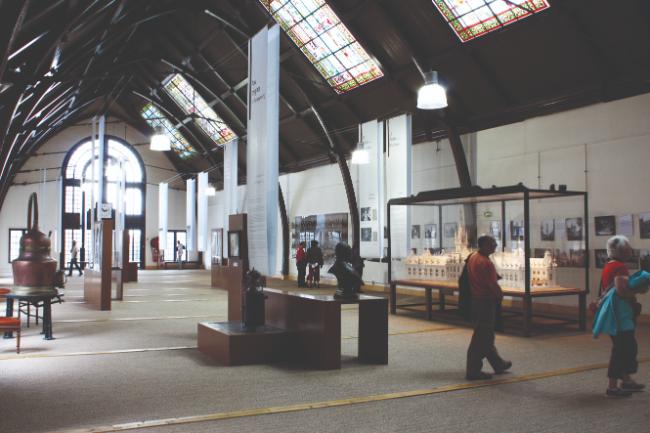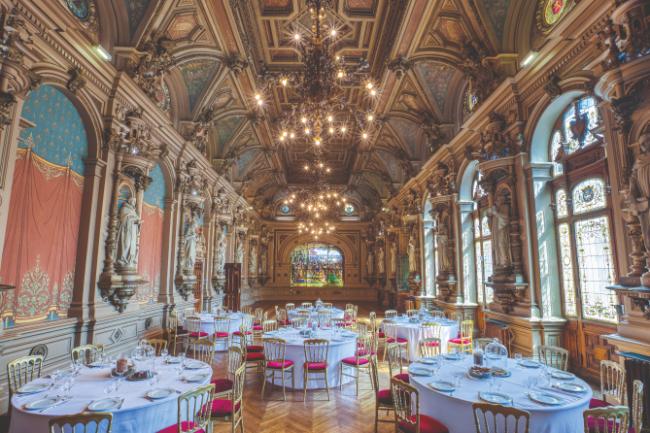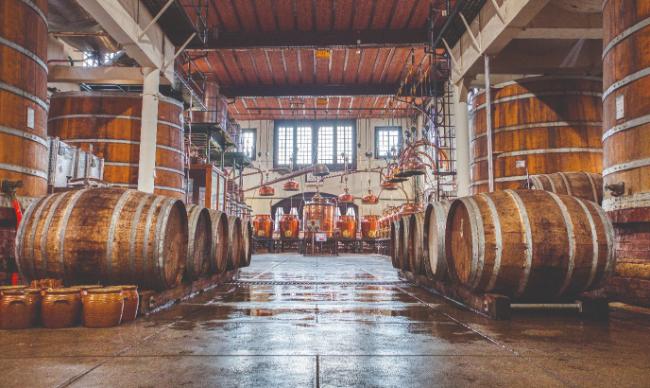Norman Elixir: Secrets of the Bénédictine Liqueur

Explore the long and often secret history of the liqueur Bénédictine, made in Fécamp, Normandy.
Bound in beige leather, with a coat of arms embossed dead centre on the front cover, the 16th-century book has a certain gravitas to it. Having removed it from its safe, Sébastien Roncin, the archivist for French liqueur brand Bénédictine, presents it to me on a red velvet tray. ‘Le Grimoire’, he calls it – in other words, ‘the book of magic spells’, and it certainly resembles something you might purchase in the magic shop from the Harry Potter books. But he won’t let me touch the dusty tome, let alone look inside its pages.
Then he shows me a second old book; this one red, also with a coat of arms embossed on its cover, but more recent, dating from 1863 when local wine merchant Alexandre Le Grand wrote in it his recipe for Bénédictine. Roncin allows me to view just the title page, signed in scratchy fountain pen, but I can look no further into the book. Rumour has it that only three living people at any one time are allowed to know the secret recipe that is hidden within.
I ask Roncin about this need for secrecy. “The people who work on producing the liqueur do not know the recipe in its entirety, but only what they need to know,” he says, insisting he is unaware whether other written versions of the recipe exist elsewhere. Clearly there’s an element of theatre to all this. But as I glance at both ancient volumes, I can’t help feeling I’ve been admitted into some sort of inner circle. “Visitors are free to doubt it or to believe it,” Roncin tells me enigmatically.

The bar at the palace © Vincent Rustuel / Bacardi Bénédictine
An inspired herbalist
The back story of Bénédictine, one of France best-loved and most famous liqueurs, is possibly apocryphal, but it’s highly intriguing all the same. According to the drinks company Bacardi, which now owns the liqueur, it was back in 1510 that Dom Bernardo Vincelli, a Bénédictine monk and “inspired herbalist” who hailed from Venice, invented the recipe for a new elixir. At the time, he lived at the Abbaye de Fécamp, in the Norman coastal town of the same name.
Vincelli’s alcoholic concoction proved so popular that, after his death, Bénédictine monks continued to distil it at the abbey for the next few centuries. It gradually became a firm favourite among the locals and the wider Norman community. Unfortunately, by the late 1700s, amid all the political and religious chaos of the Revolution, the recipe for the elixir was lost. It wasn’t until 1863, when Alexandre Le Grand came onto the scene, that it was again discovered. Browsing through his family library, he stumbled upon the original ingredients – “almost illegible” – in an old book. His interest piqued, he spent a year or so experimenting with the various plants, berries, herbs and spices involved in an attempt to recreate the mysterious brew. The end result, which he named in honour of the monk who first distilled it, is the liqueur we know today.
Would the drink be quite as famous, however, if it weren’t for the very grand palace in which it is distilled? This impressive edifice, right in the heart of Fécamp (Seine-Maritime), was also down to Le Grand. In 1888 he enlisted architect Camille Albert to design the first palace which, tragically, burnt down soon after completion. Its replacement, “rebuilt even bigger and more beautiful”, is the huge half-gothic, half-renaissance-style palace you can visit today. Inside, as well as the Bénédictine distillery and cellars, there’s a museum and art gallery full of Le Grand’s and his ancestors’ collections paintings, reliquaries, liturgical objects, silver items and manuscripts as well as a whole room celebrating the cultural and economic impact of the famous liqueur.
It’s this that is the most interesting aspect of the palace tour. Le Grand was a great distiller, yes, but an even greater marketing man. As well as his recipe, he trademarked four aspects on his distinctively-shaped bottles: the shape of the bottle; the embossed red seal; the name Bénédictine; and the abbreviation D.O.M. on the label (which stands for Deo Optimo Maximo in Latin, meaning to God, most good, most great).

The exhibition space inside the palace © OIT Fécamp
A closely guarded secret
Inspired by the drink’s success, many forgers have tried to emulate it, and over the years, the distillers have prosecuted more than 1,000 rivals for infringing their trademarks in one way or another. An intriguing aspect of the palace is what they call their Salle des Contrefaçons, or Hall of Counterfeits, where they display dozens of confiscated fake bottles, fake red badges and fake Bénédictine brandings. Imitation, as they say, is the sincerest form of flattery.
For Le Grand, the book in which his recipe was written was always a closely guarded secret. Verging on the paranoid, he used to carry it on his person whenever he travelled away from home, to prevent anyone sneaking a look. It happened that, on the day he died in June 1898, he was away on work in Paris. The minute his son learnt of his father’s death, he rushed to the capital to retrieve the precious book. Deep downstairs in the Palais de Bénédictine is where you find the machinery behind this recipe – the distillery and cellars. Here, dozens of copper stills and vast oak barrels house the liqueur in its various stages of distillation.
There are 27 different herbs, plants and spices mixed into the drink. Some are local, some come from Italy and others from the Far East. The distillers will reveal 15 of them – including nutmeg, cinnamon, hyssop, lemon balm, mace, honey, caramel, liquid sugar and saffron – but choose to keep the remaining 12 secret.
The preparation of these ingredients is the job of Bacardi’s master of botanicals, Alessandro Garneri, at the company’s headquarters in Geneva. After mixing the ingredients according to the recipe, he delivers them to Fécamp. Mickael Durand, in charge of drinks production at Bénédictine, claims Garneri is the only person privy to the actual recipe. “The composition and quantity are known only to this herbalist,” he says. “But each distiller contributes to the creation of the liqueur through their knowledge and savoir-faire.”
This is when the real work begins. Distillers split the ingredients into four preparations, using maceration (with lemon peel), infusion, single distillation and double distillation. The four resulting spirits are then mixed together and aged in oak barrels for eight months, after which saffron and honey is added. The final blend is then heated to 55°C before resting in the cellar for a further four months. “All the ingredients merge,” the distillers say. “The alchemy works.” Only then can it be filtered and finally bottled.

The four styles of drink made by the distillers at Bénédictine © Dominic Bliss
Mixing it up
Bacardi sell four different Bénédictine drinks: the original (Le Grand’s first 1863 recipe); B&B (Bénédictine and brandy, dating from 1937); Single Cask (a drier version of B&B, first launched in 2000); and 1888 (the newest liqueur, a mixture of Bénédictine and Baron Otard cognac). At the end of my palace tour, I’m fortunate to be offered all four versions to taste. The drink remains popular as a digestif or mixed into a cocktail. It’s the drier Single Cask that appeals to my palate the most.
Among French drinkers, it has fallen out of favour in recent years, though. Back in the 1980s, three million bottles a year used to sell to the domestic market, but that figure has since dropped markedly. Nowadays, the main market is Malaysia and Singapore, boosted no doubt by its inclusion in the famous Singapore Sling cocktail. There’s even a notion in the Far East – an entirely unscientific one, mind – that Bénédictine offers certain health benefits to pregnant women.
There is one tiny pocket in Europe, however, where Bénédictine is more popular than ever. Bizarrely, it’s not in France, but across the Channel in England – in the Lancashire town of Burnley, to be precise. Here, at the Burnley Miners’ Social Club, the hundreds of members imbibe around 1,000 bottles a year, making them the world’s keenest consumers of Bénédictine. One of the lounges at the club has even been named after it.

The ‘Salle des Abbés’ within the palace © Vincent Rustuel / Bacardi-Bénédictine
A wartime tipple
It all dates back to the First World War when soldiers from East Lancashire were billeted in Normandy where they developed a taste for Bénédictine mixed with hot water (‘Benny ‘n’ hot’, they called it), which helped to keep them warm in the trenches. On their return to Lancashire they missed the drink and placed regular orders to have it delivered. It has been making the journey to the north of England in large quantities ever since.
Bénédictine is also a favourite at Burnley Football Club, where it keeps fans warm in the stands on match days. In 2019, the club partnered with the French distiller to create ‘the Bénédictine Man of the Match’. Instead of the traditional champagne, the top-performing player now receives a bottle of Bénédictine.
Back in Fécamp, the palace distillery is soon to mark 150 years since it opened to the public. In celebration, there’s a new Bénédictine exhibition. Soon to be added as a centrepiece is that dusty yellow grimoire I was allowed to see.
If you make the trip to Fécamp for this new exhibition, just remember: you won’t be allowed to peek inside. The recipe is still as secret as it has ever been.
From France Today Magazine

The distillery © Vincent Rustuel / Bacardi-Bénédictine
BÉNÉDICTINE ESSENTIALS
THINGS TO DO
Bénédictine offers several themed tours of the palace, ranging from a basic self-guided individual visit all the way up to cocktail making, fragrance workshops, drinks tastings and a full gourmet meal.
GETTING THERE
Dominic Bliss travelled to France on Brittany Ferries which operates up to six daily sailings to Normandy, with routes from Portsmouth to Le Havre, Caen and Cherbourg and from Poole to Cherbourg. Fares start from £103 each way for a car and two passengers. To book visit brittanyferries.com or call 0330 159 7000.
Lead photo credit : Palais Bénédictine © OIT Fécamp
Share to: Facebook Twitter LinkedIn Email
More in French liqueur, Norman drinks, Norman gastronomy, Normandy
Leave a reply
Your email address will not be published. Required fields are marked *



